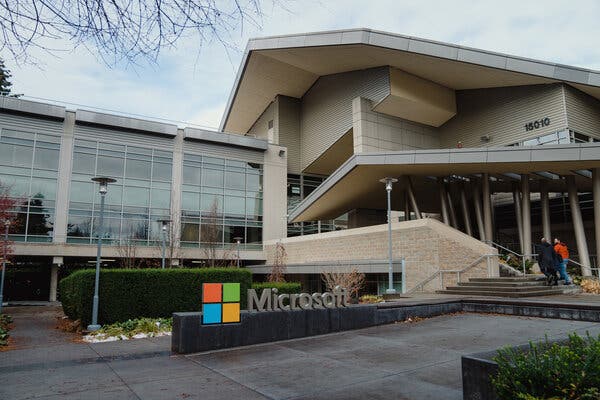
Microsoft Bets Big on the Creator of ChatGPT in Race to Dominate A.I.
When a chatbot called ChatGPT hit the internet late last year, executives at a number of Silicon Valley companies worried they were suddenly dealing with new artificial intelligence technology that could disrupt their businesses.
But at Microsoft, it was a cause for celebration. For several years, Satya Nadella, Microsoft’s chief executive, had been putting the pieces in place for this moment.
In 2019, Microsoft invested $1 billion in OpenAI, the tiny San Francisco company that designed ChatGPT. And in the years since, it has quietly invested another $2 billion, according to two people familiar with the investment who requested anonymity because they were not authorized to speak with the media.
The $3 billion paid for the huge amounts of computing power that OpenAI needed to build the chatbot. And it meant that Microsoft could rapidly build and deploy new products based on the technology.
Microsoft is now poised to challenge Big Tech competitors like Google, Amazon and Apple with a technological advantage the company has not possessed for more than two decades. Microsoft is in talks to invest another $10 billion in OpenAI as it seeks to push its technology even further, according to a person familiar with the matter.
The potential $10 billion deal — which would mainly provide OpenAI with even larger amounts of computing power — has not been finalized and the funding amount could change. But the talks are indicative of the tech giant’s determination to be on the leading edge of what has become the hottest technology in the tech industry.
Mr. Nadella worked with A.I. technologies when he ran Microsoft’s Bing search engine more than a decade ago, and for several years he has convened a biweekly internal meeting of A.I. leaders.
“The expectation from Satya is that we’re pushing the envelope in A.I., and we’re going to do that across our products,” Eric Boyd, the executive responsible Microsoft’s A.I. platform team, said in an interview.
Microsoft’s new talks with OpenAI were reported earlier by Semafor. Its additional $2 billion investment in the company was earlier reported by The Information and Fortune.
ChatGPT answers questions, writes poetry and riffs on almost any topic tossed its way. Based on earlier technologies called GPT-3 and GPT-3.5, it is the most conspicuous example of technology called generative artificial intelligence, the term for a system that can generate text, images, sounds and other media in response to short prompts.
The Rise of OpenAI
The San Francisco company is one of the world’s most ambitious artificial intelligence labs. Here’s a look at some recent developments.
- ChatGPT: The new cutting-edge chatbot is inspiring awe, fear, stunts and attempts to circumvent its guardrails, our technology columnist writes.
- DALL-E 2: The system lets you create digital images simply by describing what you want to see. But for some, image generators are worrisome.
- GPT-3: With mind-boggling fluency, the natural-language system can write, argue and code. The implications for the future could be profound.
“It has already been a home run partly because Satya was prescient enough to make the bet three years ago, and because all applications will be generative in the future,” said Matt McIlwain, a managing partner at Seattle’s Madrona Venture Group.
The new generative A.I. technologies could reinvent everything from online search engines like Google to digital assistants like Alexa and Siri. Microsoft sees these technologies as a way of expanding and improving its already wide range of products for businesses, computer programmers and consumers, while boosting revenues across its Azure cloud computing services.
“It is just fascinating to see how these generative models are capturing the imagination,” Mr. Nadella told developers in India last week, adding, “I think it is a golden age.”

OpenAI is working on an even more powerful system called GPT-4, which could be released as soon as this quarter, according to Mr. McIlwain and four other people with knowledge of the effort. Microsoft declined to comment on its future product plans.
Built using Microsoft’s huge network for computer data centers, the new chatbot could be a system much like ChatGPT that solely generates text. Or it could juggle images as well as text. Some venture capitalists and Microsoft employees have already seen the service in action. But OpenAI has not yet determined whether the new system will be released with capabilities involving images.
OpenAI is led by Sam Altman, who became well known in Silicon Valley as the head the start-up builder Y Combinator. Mr. Altman, 37, and his co-founders created OpenAI in 2015 as a nonprofit. But he soon remade the venture as a for-profit company that could more aggressively pursue financing.
A year later, Microsoft invested $1 billion in the company and committed to building the supercomputer technologies OpenAI’s enormous models would demand while becoming its “preferred partner for commercializing” its technologies. OpenAI later officially licensed its technologies to Microsoft, allowing the company to directly add them to Microsoft products and services.
With backing from Microsoft, OpenAI went on to build a milestone technology called GPT-3. Known as a “large language model,” it could generate text on its own, including tweets, blog posts, news articles and even computer code.
Clunky to use, it was mostly a tool for businesses and engineers. But a year later, OpenAI began work on DALL-E, which allowed anyone to generate realistic images simply by describing what they want to saw. Microsoft incorporated GPT-3, DALL-E and similar technologies into its own products.
GitHub, a popular online service for programmers owned by Microsoft, began offering a programming tool called Copilot. As programmers built smartphone apps and other software, Copilot suggested the next line of code as they typed, much the way autocomplete tools suggest the next word as you type texts or emails.
For many, it was a “jaw dropping moment” that showed what’s possible, Mr. Boyd, of Microsoft, said.
Then, at the end of last year, OpenAI unveiled ChatGPT. More than a million people tested the chatbot during its first few days online. It answered trivia questions, explained ideas and generated everything from school papers to pop song lyrics.
Microsoft last year began incorporating DALL-E image creations into its Bing search engine, and is working with OpenAI on a new version of the search engine that would include technology along the lines of ChatGPT, according to The Information.
Google, Meta and other companies have spent years building models similar to ChatGPT. The A.I. systems develop their skills by analyzing enormous amounts of digital text, including books, Wikipedia articles, computer programs and chat logs.
“Building these systems really requires a supercomputer — and there are not many of them on the planet,” said Aiden Gomez, a former Google researcher who founded Cohere, an start-up that has built technology to ChatGPT.
In 2019, Mr. Altman told The New York Times that most of Microsoft’s $1 billion investment came in the form of the computing power OpenAI needs — and that Microsoft would eventually become the lab’s sole source of computing power.
Microsoft and OpenAI have built a new kind of supercomputer specifically for ChatGPT and other generative A.I. technologies. That means Microsoft can readily offer these systems to its own customers.
Microsoft and OpenAI hope they can improve these systems by training them on larger amounts of data and most experts agree their skills will improve. Right now, Microsoft acknowledges, they can “hallucinate” answers by mixing fact and fiction.
Speaking in India last week, Mr. Nadella presented data that indicated as much as 10 percent of all data could be A.I.-generated in just three years, which could lead to as much as $7 billion in revenue for Azure, Microsoft’s cloud computing product, said Gil Luria who researches Microsoft for the investment bank D.A. Davidson.
These technologies still come with a long list of flaws and question marks. They often produce toxic content, including misinformation, hate speech and images that are biased against women and people of color.
Microsoft, Google, Meta and other companies have been reluctant to release many of these technologies because of the potential damage to their established brands. Five years ago, Microsoft quickly backtracked after releasing a chatbot called Tay that generated racist, xenophobic and otherwise filthy language.
Mike Volpi, a partner with the venture capital firm Index Ventures, who was among the early investors in generative A.I., said the Microsoft-OpenAI partnership is one of the many contenders hoping to control where the technology is headed.
“There is an argument to be made that they all end up smelling the same,” he said. “There is another argument that what OpenAI is doing is truly special and that all the money goes to them.”
Erin Griffith and Mike Isaac contributed reporting.

